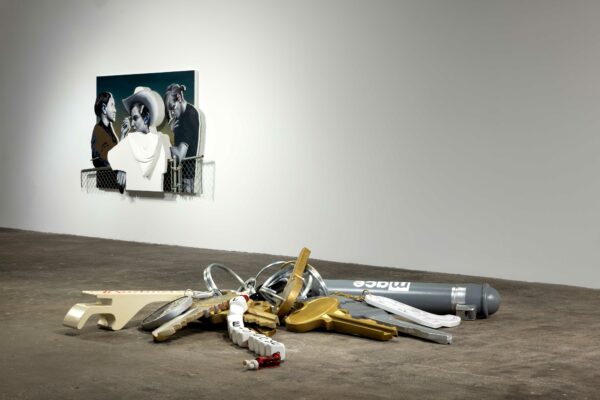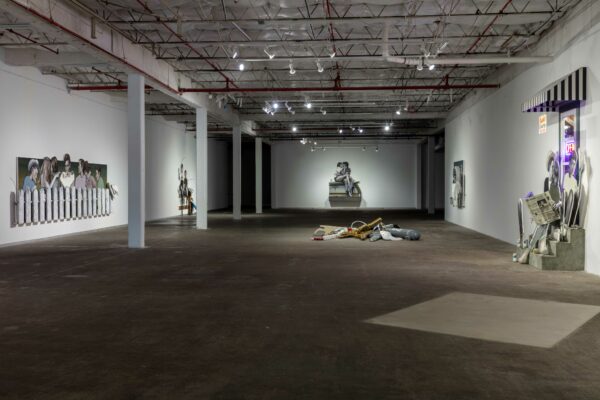Chloe Chiasson’s exhibition Keep Left at the Fork at Dallas Contemporary will likely feel familiar to those who have traveled through or spent time in small town Texas. Pole fishing, cruising and smoking, drinking on a stoop, and making out in the back of a pickup truck all appear here, and a full-scale replica of a railroad crossing at the show’s entrance is a reminder of the stop-start slowness of such a place.
Despite these similarities, Chiasson’s version is markedly different. Her larger-than-life painted sculptures are populated by young, androgynous people immersed in their own private and shared lives. When they do look in our direction, the figures gaze at us with hardened, even defensive expressions, as if they’re ready to take on any affront. Chiasson is queering the small town space, reworking what has historically been — and in many cases still is — a hostile environment to those who fall outside of its rigid norms. Her characters cherish being alone, spending time with a lover, and taking up space with friends. These small but transgressive acts forge a sense of self and an alternative sort of world.

Chloe Chiasson “Oh, The Places You’ll Go” (detail), 2023,
mixed media installation with foam, wood, steel, fiberglass, resin, rope, acrylic and oil, 126 x 120 x 17 inches. Photo: Kevin Todora
This world is a complicated one, and not fully divorced from traditional small town life. The artist’s characters have analogous ways of passing the time, and their blue jeans and sneakers show they’ve adapted a typical form of dress. Rosaries, a medallion of St. Christopher, and earrings with a cross even signal a connection to religion. But Chiasson makes her own world more real by emphasizing the things that compose it. This happens both in the materials she uses and in her amplification of objects. A River Runs Through It (2021), for example, showing three figures fishing by a wooden fence, is made with art materials like oil and acrylic paint, but also fishing line and hooks, cigarette butts, grass, and lipstick. Another work, Oh the Places You’ll Go (2023), is a roughly ten-foot, three-dimensional replica of a carabiner with keys and keychains produced in mixed media with meticulous detail.

Chloe Chiasson “Saving Grace,” 2023, oil, acrylic, steel, plexiglass, aluminum, paper, resin, foam, rosary, air freshener, locket, vinyl, graphite, canvas on shaped panel, 98 x 79 x 18 inches. Photo: Kevin Todora
The artist’s technique is fascinating. From afar, her works seem to be shaped paintings, but they’re actually layered tableaux made of painted canvas stretched on sculpted and overlapping pieces of wood that are cleverly arranged in space. Approaching and walking around each piece gently animates it. As figures’ hands, feet, and knees show themselves to exist in separate planes, our conception of the image is baffled. In fact, these works are only “composed” when seen head on; otherwise they fracture themselves into component pieces. This exciting effect echoes the complexity of the characters’ identities, but also the artist’s interest in artifice.
I wondered about this while viewing Chiasson’s admittedly impressive works. A reproduction of an April 1970 Mid County Chronicle newspaper in the hands of a figure in The Corner Store (2023) aside, it is never made explicit where the scene of these pieces is set. However, the cowboy hats, boots, and Shiner and Lone Star beer cans in many of Chiasson’s works clearly insist on Texas.
The artist grew up in Port Neches and moved to New York City in 2017, and her career there is thriving. I could not help wondering how viewers from elsewhere receive this work, and what the implications are of that reception. Chiasson’s vision of a Texas town that is also a queer refuge is valid and rich. But Texas, and especially life in its rural areas, looms large in politics and popular culture, and the typical trappings of small town Texas in Chiasson’s work could easily be experienced as exotic or quaint. The artist runs the risk of catering to such othering fantasies, and to representing an extremely complex place in caricature.
These questions made me curious about the artist’s relationship to Texas today. Perhaps Keep Left at the Fork (2023) has an answer. In the six-foot-tall sculpture of a car’s rear view mirror, the driver’s hand is partially reflected clutching a cigarette, and a highway sign for Port Neches is left behind. The driver is leaving her hometown, and far off in the distance, the sun disappears beyond the horizon. In Chiasson’s work, the sun is only ever rising or setting. It’s a place of constant transition.
Chloe Chiasson: Keep Left at the Forkis on view at Dallas Contemporary through March 17, 2024.




